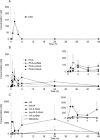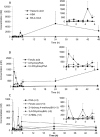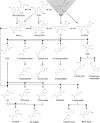The pharmacokinetics of anthocyanins and their metabolites in humans
- PMID: 24602005
- PMCID: PMC4080980
- DOI: 10.1111/bph.12676
The pharmacokinetics of anthocyanins and their metabolites in humans
Abstract
Background and purpose: Anthocyanins are phytochemicals with reported vasoactive bioactivity. However, given their instability at neutral pH, they are presumed to undergo significant degradation and subsequent biotransformation. The aim of the present study was to establish the pharmacokinetics of the metabolites of cyanidin-3-glucoside (C3G), a widely consumed dietary phytochemical with potential cardioprotective properties.
Experimental approach: A 500 mg oral bolus dose of 6,8,10,3',5'-(13)C5-C3G was fed to eight healthy male participants, followed by a 48 h collection (0, 0.5, 1, 2, 4, 6, 24, 48 h) of blood, urine and faecal samples. Samples were analysed by HPLC-ESI-MS/MS with elimination kinetics established using non-compartmental pharmacokinetic modelling.
Key results: Seventeen (13)C-labelled compounds were identified in the serum, including (13)C5-C3G, its degradation products, protocatechuic acid (PCA) and phloroglucinaldehyde (PGA), 13 metabolites of PCA and 1 metabolite derived from PGA. The maximal concentrations of the phenolic metabolites (Cmax ) ranged from 10 to 2000 nM, between 2 and 30 h (tmax) post-consumption, with half-lives of elimination observed between 0.5 and 96 h. The major phenolic metabolites identified were hippuric acid and ferulic acid, which peaked in the serum at approximately 16 and 8 h respectively.
Conclusions and implications: Anthocyanins are metabolized to a structurally diverse range of metabolites that exhibit dynamic kinetic profiles. Understanding the elimination kinetics of these metabolites is key to the design of future studies examining their utility in dietary interventions or as therapeutics for disease risk reduction.
Keywords: anthocyanins; ferulic acid; hippuric acid; metabolites; vanillic acid.
© 2014 The Authors. British Journal of Pharmacology published by John Wiley & Sons Ltd on behalf of The British Pharmacological Society.
Figures






References
-
- Azzini E, Bugianesi R, Romano F, Di Venere D, Miccadei S, Durazzo A, et al. Absorption and metabolism of bioactive molecules after oral consumption of cooked edible heads of Cynara scolymus L. (cultivar Violetto di Provenza) in human subjects: a pilot study. Br J Nutr. 2007;97:963–969. - PubMed
-
- Bell DR, Gochenaur K. Direct vasoactive and vasoprotective properties of anthocyanin-rich extracts. J Appl Physiol. 2006;100:1164–1170. - PubMed
-
- Cardona F, Andrés-Lacueva C, Tulipani S, Tinahones FJ, Queipo-Ortuño MI. Benefits of polyphenols on gut microbiota and implications in human health. J Nutr Biochem. 2013;24:1415–1422. - PubMed
Publication types
MeSH terms
Substances
Grants and funding
- BB/H004963/1/BB_/Biotechnology and Biological Sciences Research Council/United Kingdom
- BB/H00503X/1/BB_/Biotechnology and Biological Sciences Research Council/United Kingdom
- BB/H004726/BB_/Biotechnology and Biological Sciences Research Council/United Kingdom
- BB/J004545/1/BB_/Biotechnology and Biological Sciences Research Council/United Kingdom
LinkOut - more resources
Full Text Sources
Other Literature Sources
Medical
Miscellaneous

